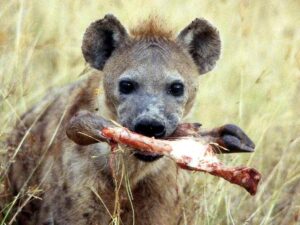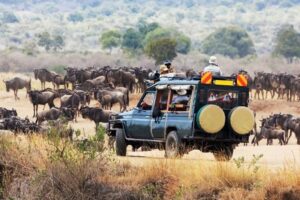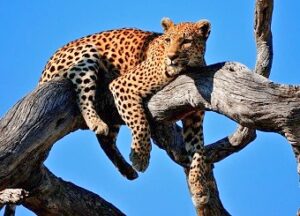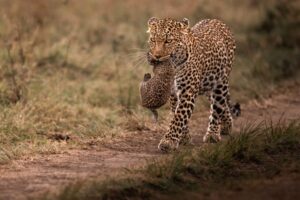Kenya isn’t just another safari destination it’s the heart of wild Africa for anyone with a camera and a passion for wildlife, there’s really nowhere quite like it.
From the sweeping savannahs of the Maasai Mara to the dramatic landscapes of Samburu and the quiet wetlands of Amboseli with Mount Kilimanjaro in the background, Kenya offers the best seat to nature at its rawest and most beautiful.
I know some of you would ask Why Kenya and not any other destination? Worry less Naicef got your back!
What makes Kenya special isn’t just the animals it’s how easy it is to get close to them in their natural habitat.
The country has one of the highest densities and varieties of wildlife in Africa, and its well established national parks and conservancies make it incredibly photography friendly.
You’ll find everything from lions and leopards to cheetahs, elephants, rhinos, giraffes, and huge herds of wildebeest often in just one game drive.
And then there’s the light. Photographers love Kenya for its golden hours.
Early morning and late afternoon light in the bush is something else it gives your shots that soft, warm tone that just doesn’t happen anywhere else.
The dry season also offers clear skies and dramatic dust in the air, which can really make action shots pop.
What are you waiting for contact my@naicef.com or call +254799922277 for the best experiences across all destinations in Kenya!
Book The Tour Here

Best Wildlife Photography Backpack
When you’re out exploring the wild beauty of Kenya from the dusty plains of the Maasai Mara to the lush, green swamps of Amboseli you need more than just a camera.
You need a wildlife photography backpack that can keep up. The right bag isn’t just about storage it’s your mobile base in the field.
It should be tough enough to handle bumpy rides and unpredictable weather, yet light and comfortable enough to carry all day during game drives or treks.
Look for something that has smart compartments for separating your lenses, camera bodies, and accessories so everything stays protected and easy to reach when the action starts.
Quick access is key because in the wild, things happen fast. It helps if the backpack is weather resistant, with extra features like external straps for your tripod or monopod, and even a hydration pocket for those long days under the sun.
Popular choices among photographers in Kenya include trusted brands like Lowepro, Think Tank, and Shimoda designed with both function and comfort in mind.
Before committing to one, load it with your actual gear and try it on to make sure it feels right.
A poorly balanced or flimsy bag can slow you down or worse, damage your equipment when it matters most.
In the end, investing in a solid wildlife photography backpack is just as important as choosing the right lens. It’s what helps you stay ready for that rare shot.
What Park in Kenya Has the Best Wildlife for Photography?
Kenya has no shortage of spectacular parks, but what park in Kenya has the best wildlife for photography?
While several parks offer incredible photographic opportunities, the Maasai Mara consistently tops the list.
It’s here that you’ll witness the Great Migration, one of the most breathtaking wildlife events on Earth. So again, what park in Kenya has the best wildlife for photography?
So again, what park in Kenya has the best wildlife for photography?
The answer still remains Maasai Mara, especially between July and October when over a million wildebeest, zebras, and gazelles cross the Mara River, with predators lurking nearby.
That said, Amboseli National Park, with its postcard views of elephants against Mount Kilimanjaro, also deserves attention.
Samburu, Tsavo, and Lake Nakuru each have their unique offerings too.
However, when it comes down to the question of which park in Kenya offers the best wildlife photography, most professionals and enthusiasts still put Maasai Mara at the top.
Its high density of big cats, incredible natural light, and the ease of spotting and photographing animals make it a standout choice
Here are the best places where you can enjoy photography in Kenya I mean best spots for photography:
1. Maasai Mara National Reserve
Maasai Mara is Kenya’s top destination for wildlife photography, known for its endless golden plains, big cats, and the dramatic Great Migration that happens from July to October.
It offers photographers incredible opportunities to capture lions, cheetahs, and river crossings filled with tension and dust in perfect golden light.
With its open landscapes, rich wildlife activity, and experienced guides who understand photography, it’s one of the best places in Africa to get unforgettable, unique shots in a natural setting.
Visit Naicef and see the 3 Days Maasai mara photography safari and Below is a sketch of a package on 3 days Maasai mara cultural package
| Time | Activity | Caption |
| Day 1 | ||
| 6.00 am | Pick from hotel or Airport | Quick stopover at the great rift valley for photo sessions |
| 6.00 am – 12 pm | Depart for Maasai mara | You will come across Italian chapet and Mt. Longonot earth satellite. Stopover at Narok town, head to your lodge |
| 12pm – 2pm | Check in at Maasai mara Sopa lodge, have lunch | Check in and have meals |
| 2pm – 4pm | Cultural Excursions | Be welcomed by Maasai traditions and customs |
| 4pm | Personal time | |
| Day 2 | ||
| 10.00 am – 4.00 pm | Full day cultural tour | Spend full day enjoying and learning from masaa people |
| After 4.00pm | Evening game drive | You may choose to have evening game drives at the plain of the reserve |
| Day 3 | ||
| Before 10.00 am | Breakfast and checkout | Check out at Maasai mara sopa lodge after breakfast |
| 10.00 am – 1.00pm | Village tour and travel back to Nairobi | Enjoy final visit to local Maasai village |
| 1.00 pm – 2.00 pm | Lunch | Lunch in Nairobi |
| After 2.00 pm | Drop off | Drop off at a hotel or JKIA |
2. Amboseli National Park
Amboseli is a dream for wildlife photographers, especially those after iconic shots of massive elephants roaming freely across open plains with Mount Kilimanjaro towering in the background.
The park’s low vegetation and wide sightlines make it easy to photograph animals in motion without obstruction, while the early morning and late evening light adds a dramatic touch.
From dust kicking elephant herds to reflective wetlands filled with birdlife, Amboseli offers a unique blend of striking landscapes and rich wildlife activity that’s perfect for capturing powerful, cinematic images.
Below is a sketch of a 3 Day Amboseli National pack culture tour
| Time | Activity |
| Day 1 | |
| 6.00 am | Pick up at the hotel/ CBD or Airport |
| 12.00 pm | Checking In |
| 2.00 pm | Cultural tour |
| 4.00 pm | Personal time / game drive |
| 6.00 pm | Dinner and evening at Amboseli Sopa lodge |
| Day 2 | |
| 10.00 am | Full day Amboseli cultural experience |
| 1.00 pm | Lunch |
| 4.00 pm | Personal time / evening game drive |
| 6.00 pm | Dinner & overnight at Amboseli Sopa lodge |
| Day 3 | |
| 10.00 am | Check out |
| 1.00 pm | Lunch |
| 2.00 pm | Nairobi drop off |
3. Samburu National Reserve
Samburu offers a raw, rugged, and truly unique photography experience in Kenya’s northern frontier.
Its arid landscapes, rocky hills, and dry riverbeds create rich, earthy tones that stand out in photos.
What sets Samburu apart is its rare wildlife the Samburu Special Five found nowhere else together in Kenya.
With fewer tourists, animals are calmer and easier to photograph up close, especially around the Ewaso Nyiro River.
Though midday light can be harsh, the golden hours bring out deep shadows and bold contrasts, making Samburu a perfect destination for dramatic and intimate wildlife photography.
4. Lake Nakuru National Park
Lake Nakuru may be small, but it’s packed with photographic variety.
Famous for its vibrant flamingo flocks lining the lake’s edges, it offers stunning bird photography with reflective waters and forested hills in the background.
Beyond the birds, it’s one of the top spots in Kenya to capture both black and white rhinos, often up close, along with chances to spot leopards and Rothschild’s giraffes.
The park’s mix of acacia woodlands, rocky cliffs, and elevated viewpoints gives photographers the perfect setting for combining landscapes, birdlife, and large mammals all in one frame.
see a package by Naicef on Lake Nakuru; 3 Days Nakuru Bird watching In Kenya safari
5. Laikipia Conservancies
Laikipia county is a photographer’s haven made up of private conservancies that offer a more exclusive and flexible wildlife photography experience.
With fewer vehicles and a strong conservation focus, it allows for clean, crowd-free shots and the freedom to explore off road or on foot.
It’s one of the few places in Kenya where you can photograph rare species like African wild dogs, Jackson’s hartebeest, and even the elusive black panther.
The diverse landscapes ranging from rocky ridges to lush river valleys give photographers the chance to capture everything from tight animal portraits to sweeping, scenic frames.
6. Tsavo East and Tsavo West National Parks
Tsavo East and Tsavo West together form Kenya’s largest wildlife area and offer a rugged, remote photography experience far from the usual tourist trails.
Known for their iconic red-dust elephants, these parks provide raw, earthy scenes that give your images a distinctive and dramatic look.
Tsavo East’s vast, open landscapes let you shoot wildlife in complete solitude, while Tsavo West offers more vegetation and unique spots like Mzima Springs for underwater shots of hippos and fish.
Though midday light can be harsh, the golden hours bathe the red soil and hazy air in soft tones perfect for bold, atmospheric photography.
See the packages provided by Naicef on Tsavo East and Tsavo west highlighted below:
7. Ol Pejeta Conservancy
Ol Pejeta is one of Kenya’s most meaningful photography destinations, offering rare access to the last two northern white rhinos on Earth an emotional and powerful subject for any wildlife photographer.
Set in central Kenya, the conservancy blends conservation with accessibility, giving you the chance to capture both black and white rhinos in beautiful, varied landscapes.
It’s also the only place in Kenya with a chimpanzee sanctuary, ideal for close-up primate shots.
With fewer vehicles, flexible game drives, and expert guides who understand lighting and positioning, Ol Pejeta delivers both intimate encounters and strong photographic opportunities all framed by the stunning backdrop of Mount Kenya.
Best Wildlife Photography Camera
Choosing the best wildlife photography camera is another critical decision when planning your Kenyan adventure.
The best wildlife photography camera needs to offer fast autofocus, high frame rates, and excellent low-light performance. Many wildlife photographers lean toward mirrorless systems with full-frame sensors.
Many wildlife photographers lean toward mirrorless systems with full-frame sensors.
Canon’s, Sony’s, and Nikon’s are often mentioned as the best wildlife photography camera options due to their speed, sharpness, and ability to shoot silently a huge advantage when trying not to disturb animals.
It’s also important to consider weather-sealing and battery life. Game drives can last all day, and power sources aren’t always available in the bush.
A rugged body that can handle dust, heat, and the occasional bump is crucial.
Some photographers also carry a backup body just in case something fails in the field.
Your camera is the heart of your gear setup, so don’t compromise.
Best Wildlife Photography Lens
You can have the best camera body in the world, but without the best wildlife photography lens, your images may fall short.
The best wildlife photography lens should give you reach and flexibility.
In Kenya, you’ll often need lenses with a focal range of at least 300mm to 600mm to capture distant animals without disturbing them. Popular choices for the best wildlife photography lens include the Canon RF 100-500mm, Sony 200-600mm G, and Nikon’s 180-600mm.
Popular choices for the best wildlife photography lens include the Canon RF 100-500mm, Sony 200-600mm G, and Nikon’s 180-600mm.
Image stabilization and fast aperture can be valuable, especially during dawn or dusk shoots.
A good wildlife lens should also be sharp, lightweight if possible, and compatible with teleconverters for that extra zoom.
It’s worth renting or testing out lenses before your trip to make sure they fit your shooting style and comfort level.
Best Time for Photography
Dry Season (June to October)
This is the best time for spotting big game. As water sources dry up, animals gather around remaining waterholes, making sightings more predictable.
If you’re heading to the Maasai Mara, this is when the Great Migration peaks expect dramatic river crossings, large herds, and plenty of predator action.
Green Season (November to March)
Also known as the secret season, this is when the landscape comes alive.
Expect lush greenery, vibrant skies, and fewer tourists. It’s ideal for bird photography, as migratory species arrive in large numbers.
You’ll also capture more atmospheric shots with moody clouds and soft light after rains.
Camera Equipment Essentials
1. Camera Body: Bring a DSLR or mirrorless camera with fast and accurate autofocus. Wildlife moves fast you’ll want gear that can keep up.
2. Lenses: A zoom lens like a 100–400mm or 200–600mm is perfect for wildlife. You’ll need the reach. Also pack a 24–70mm for wider shots—think landscapes, herds, or inside the safari vehicle.
3. Support Gear: A bean bag or monopod helps stabilize your shots in the vehicle. Tripods are usually too bulky and difficult to set up during drives.
4. Storage & Power: Always bring extra memory cards and batteries. You’ll shoot more than you expect often in burst mode and charging options in the bush can be limited.
Why It’s Expensive
1. Park Fees: These are charged per person, per day, and can add up quickly, especially in premium reserves like the Serengeti or Maasai Mara.
2. Private Vehicles: To have the freedom to move, wait, or position for the perfect shot, a private vehicle is often essential but it comes at a cost.
3. Specialist Guides: Wildlife guides trained in photography or custom photo safaris can dramatically improve your results, but they typically charge more than standard guides.
4. Travel Logistics: Getting to prime locations like the Mara Triangle often requires domestic bush flights, which are more expensive but save you long, bumpy drives.
5. Accommodation: Staying close to wildlife hotspots often means higher-end lodges or camps. These offer early access to game drives and better shooting opportunities, especially in golden hour.
Best Wildlife Photography Books in Kenya
Before heading out into the wild, educate yourself with some of the best wildlife photography books in Kenya.
These resources can guide you through understanding animal behavior, mastering composition, and learning the local light conditions.
Some of the best wildlife photography books in Kenya include titles like Through the Lens of Kenya by Jonathan and Angela Scott, Photographing East Africa by Martin Harvey, and Eyes Over Africa: Kenya by Michael Poliza.
Each of these captures the soul of Kenyan wildlife through powerful imagery and storytelling.
The best wildlife photography books in Kenya are not just for inspiration they also teach vital technical skills like using light, positioning, and framing.
They often share real-world examples, photo settings, and behind-the-scenes challenges photographers faced in the wild.
If you’re serious about improving your work, spending time with the best wildlife photography books in Kenya is a smart move.
Conclusion
Kenya is truly a wildlife photographer’s paradise.
From the vast, golden savannahs of the Maasai Mara to the misty foothills of Mount Kenya and the dry open plains of Amboseli, every corner of the country offers a chance to witness nature at its rawest and most awe-inspiring.
But to truly make the most of your safari, preparation is key.
Start by investing in the Best Wildlife Photography Backpack you’ll need something rugged, weather-resistant, and comfortable for long drives and bush treks.
A well-designed backpack ensures that your gear is protected from dust, moisture, and bumpy trails, while keeping your essentials easily accessible.
Many professional photographers swear by models with modular compartments and quick side access. Don’t underestimate this choice it can make or break your experience.
So again, finding the Best Wildlife Photography Backpack tailored for safari use is a smart and necessary step.
When it comes to destinations, you might wonder: What Park in Kenya Has the Best Wildlife for Photography?
Without a doubt, the Maasai Mara takes the crown during the Great Migration, with thousands of wildebeest, dramatic predator-prey encounters, and sweeping open spaces perfect for clean compositions.
That said, Amboseli offers jaw-dropping scenes of elephants walking beneath the snow-capped peak of Mount Kilimanjaro ideal for those epic, wide-angle shots.
And let’s not forget Samburu, which is less crowded and features unique species.
Still asking yourself What Park in Kenya Has the Best Wildlife for Photography? The answer depends on your style: action-packed drama in the Mara, iconic scenery in Amboseli, or rare species in Samburu.
Gear matters too. Choosing the Best Wildlife Photography Camera is one of the most important decisions you’ll make.
Look for a body with fast autofocus, excellent low-light performance, and good weather sealing.
Models like the Canon R5, Sony A1, or Nikon Z9 are popular among professionals for a reason.
Your camera needs to be ready for the unexpected because in the bush, moments are fleeting. Reconsidering your setup?
Choosing the Best Wildlife Photography Camera for your specific needs whether you prioritize speed, resolution, or durability will elevate your results significantly.
Alongside the right body, don’t forget the Best Wildlife Photography Lens.
A telephoto lens like a 100–400mm or 200–600mm is perfect for getting close to the action without disturbing the animals.
You’ll also want a wide-angle lens for dramatic landscapes and environmental portraits. Flexibility is key.
The Best Wildlife Photography Lens isn’t necessarily the most expensive it’s the one that allows you to tell the story you’re there to capture.
And while your camera and lens are your tools, your mind is your true weapon. Before and during your trip, dive into the Best Wildlife Photography Books in Kenya.
These books offer not just technical tips but also deep insights into animal behavior, conservation issues, and composition strategies tailored for African wildlife.
Many are written by local experts or veteran photographers who’ve spent decades in the bush.
Don’t overlook the value of reading the Best Wildlife Photography Books in Kenya they can shape how you see and shoot, turning good photos into great ones.
So, whether you’re stalking lions on the Maasai Mara plains or waiting for elephants beneath Kilimanjaro, remember:
With the right gear, the right knowledge, and the right mindset, the magic of Kenya is always within your lens.
What are you waiting for contact my@naicef.com or call +254799922277 for the best experiences across all destinations in Kenya!
Book The Tour Here
Frequently Asked Questions
1. Do I need a professional camera to take good wildlife photos in Kenya?
Not necessarily. While professional gear offers more features, a well-used mid-range DSLR or mirrorless camera with a good lens can still capture stunning images.
2. Is the Maasai Mara the only good place for wildlife photography in Kenya?
No. While it’s the most famous, parks like Amboseli, Samburu, and Tsavo also offer rich opportunities for wildlife shots.
3. Can I rent photography gear in Kenya?
Yes, there are several reputable rental services in Nairobi that offer cameras, lenses, and accessories, which is handy if you don’t want to travel with your full kit.
4. How do I protect my gear from dust and moisture in the bush?
Use weather-sealed bags, silica gel packs, and lens covers. A best wildlife photography backpack will also help protect your gear from the elements.
5. What’s the best time of year for wildlife photography in Kenya?
The dry season (June to October) is ideal, especially during the Great Migration in the Maasai Mara, when animals gather around water sources and visibility is high.




